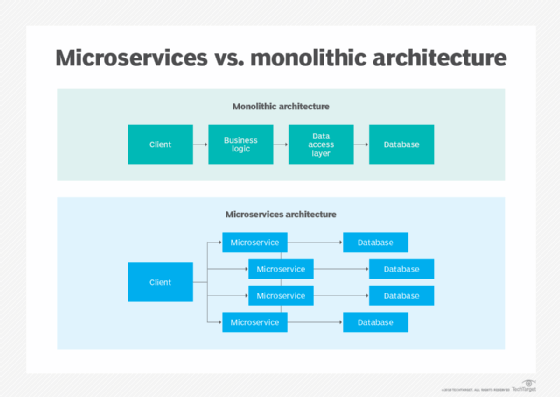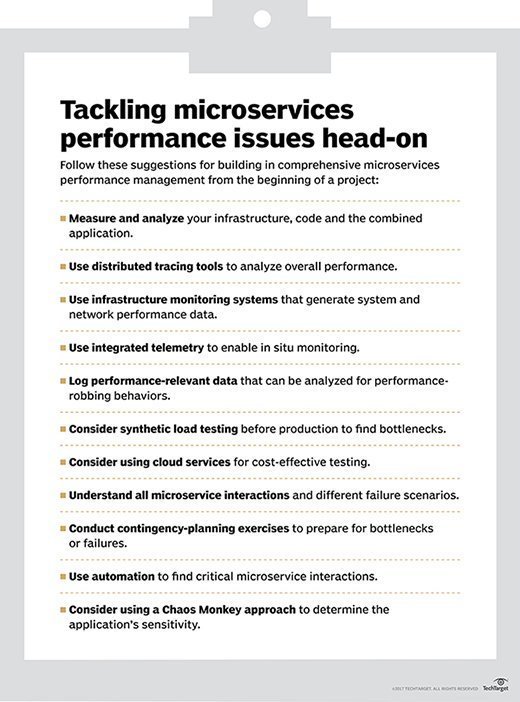11 real benefits of microservices
There's a reason why so many vendors have moved from monoliths to microservices. Here are 11 real benefits microservices bring to companies.
The proliferation of microservices is a beautiful example of a situation where the trend magically aligns with the interests of users, vendors, management and consumers alike.
Replacing monolithic architectures with microservices presents some challenges, to be sure. These include the following:
- Increased topological complexity.
- Integration overhead and dependency hell.
- Data translation and incompatibilities.
- Network congestion and decreased performance.
- More complex testing, debugging, logging and tracing.
- Organizational inertia.
Nevertheless, committed organizations can overcome these drawbacks and successfully implement a microservices strategy, and embrace a cloud-native future built upon technologies such as containers and Kubernetes.
Benefits of microservices
Here are some of the key benefits of microservices adoption. Use these to inspire your team, or sell leaders in the organization on your microservices strategy:
- Architecture- and language-neutral.
- Software component best practices, such as domain-driven design and event-driven architecture.
- Agile team alignment.
- Open source and community driven.
- Scalable on cheap commodity hardware.
- Reduced startup times.
- Usage pattern alignment.
- Hardware resource mapping.
- Release schedule flexibility.
- Isolated updates and deployments.
- Independent revisions.
Architecture-neutral
The deployment model for microservices is to package components in containers and manage those containers with an orchestration tool, typically Kubernetes.
This article is part of
What are microservices? Everything you need to know
Because every cloud vendor in the world supports container-based deployment, a Docker or Podman packaged microservice can run in anybody's cloud.
Furthermore, the installation of Docker and Kubernetes in private data center is a standard task these days, so container packaged microservices have full privileges in on-premises architectures.
The architecture-neutral deployment model is one of the key benefits of microservices, and it benefits vendors and users equally well.
Language-neutral
Microservices communicate with each other through RESTful APIs that operate over the ubiquitous HTTP protocol.
As long as a microservice exchanges information via this common communication pattern, how it is implemented under the covers is of no concern to its consumers. This means a microservice can be written in any of the following languages, and more:
- Java.
- Python.
- C++.
- Rust.
- Mojo.
- COBOL.
The ability for development teams to pick the programming language best suited to the task is a giant benefit of microservices. Consider the following scenarios:
- Need a quick script that interacts with a machine learning model? Use Python.
- Need enterprise connectivity to relational databases and message queues? Use Java.
- Want to use the skills of a team that also builds Android apps? Use Kotlin.
In the past, organizations were either locked into Java EE-based deployments or development with Microsoft .NET components. Removing this lock-in and creating a more egalitarian development and deployment ecosystem is one of the key benefits of microservices.
Design patterns and best practices
Roll the clock back 15 years, and you'll hear technology evangelists encouraging developers to embrace all the same design patterns that microservices embody today, including the following:
- Loose coupling with high cohesion.
- Event-driven architectures.
- Externalized configuration.
- Easily accessible service registries.
- Domain-driven design.
These design concepts are foundational with microservices, but they aren't new. The technology simply didn't exist 15 or 20 years ago to make these ideas a reality.
It's one thing to talk about domain-driven design and loose coupling, but it's extremely difficult to implement when the deployment targets reward teams that develop tightly coupled, architecture-driven monolithic applications.
One of the biggest microservices benefits is that software developers and application designers can finally create software components that embrace the ideals and standards the community has always recognized as best practices and optimal designs.
Domain-driven design
The benefits of domain-driven design, introduced in Eric Evans' 2004 book of the same name, have long been championed by the software development community. Essentially, these describe how a cohesive slice of functionality, such as billing, invoicing, marketing or streaming, is self-contained within a single, logical component.
However, traditional monolithic architectures do not blend well with this software development approach. In monoliths, every domain accesses a common, centralized, relational database through a common data layer and set of middle-tier services.
One of the key benefits of microservices is that they can incorporate technologies such as lightweight, dedicated NoSQL databases that can scale in tandem with the domain they support, which enables the creation of domain-driven architectures.

Agile team alignment
The domain-driven approach to the development of smaller, highly cohesive components maps neatly into the tenets of the most popular Agile frameworks and methodologies, including Scrum, Kanban and extreme programming.
Effective Agile teams must be small and focused. For example, Scrum limits the size of a team to 10 people, including the Scrum master and product owner. When teams get larger than that, the human dynamics are difficult to manage.
Microservices break down monolithic applications into smaller, more manageable components. This aligns more closely with small-team assignments than does the development of larger, monolithic systems.
A key benefit of microservices is that they help teams be more aligned with Agile and less like Waterfall development.
Open source and community driven
The key technologies that have driven the proliferation of microservices are all open source and community driven, notably the following:
- Kubernetes.
- Docker.
- Fluentd.
- Helm.
- Linux.
However, don't think for a minute that these open source projects are maintained by a bunch of teenage hackers from their parent's basements.
In fact, the biggest contributors to these open source projects include some well-known companies:
- IBM.
- Intel.
- Google.
- Microsoft.
The biggest vendors understand that supporting, maintaining and contributing to free, open source software is a great way to attract users to their profitable products and services.
Scalable on cheap commodity hardware
The technologies that support microservices at runtime, such as Docker and Kubernetes, were designed to run on cheap, off-the-shelf, commodity hardware.
With a microservice deployed into a Kubernetes cluster, you can build your own SaaS offering or enterprise hosting environment with nothing more than a used Lenovo laptop and a dedicated internet connection. As your app's popularity increases, just add another used computer to your cluster or invest in a few discount PCs.
The microservices runtime environment makes it possible for individuals and small startups with big dreams to slowly build powerful compute environments that are effective, reliable and cheap.
Microservices, along with orchestration tools like Kubernetes and Docker Swarm, snatch the power of high-capacity computing out of the hands of the big vendors that sell supercomputers, and put it in the hands of the everyday user who wants to affordably scale up runtime capacity over time.
Isolated updates and deployments
One of the biggest benefits of microservices is the ability to patch, update, enhance and restart individual parts of the runtime environment without bringing down the entire system.
Imagine an online moving service in which billing, streaming, marketing and invoicing systems are implemented as separate, but loosely coupled microservices.
One could patch, update and redeploy the billing system with no impact to the streaming service.
Nobody will cancel their Netflix account if their bill arrives a few hours later than usual. But if users can't watch Game of Thrones on demand, they'll badmouth their provider all over social media.
Three-tiered monolithic architectures often require all applications deployed to them to temporarily go offline for a redeployment of just a small part of the system.
Updates to many popular online services happen without any disruption in service. That's one of the big benefits of microservices that all of us can appreciate.
Reduced startup times
A well-designed microservice is domain-driven, singularly focused and maintains a relatively small footprint compared to microservices of the past.
The benefit? When they go down, are redeployed or just need to be restarted, the process is fast and efficient.
Throw in a few other best practices such as lazy loading and rolled-out deployments and users likely won't know that the application they're using ever went offline.
Usage pattern alignment
Not all parts of an enterprise system experience the same usage patterns. Consider the following examples:
- Streaming services tend to be very busy in the evening when people come home from work.
- Billings systems are very busy at the end of the month.
- Transactional systems that support purchases are busy around Christmas.
Traditional monolithic architectures employ an all-or-nothing type of scaling strategy. If the billing system must scale to four nodes or six JVMs, then every system must scale to four nodes or six JVMs. That's just how it works.
With a microservices-based architecture, you can scale any individual component without the need to involve other services. Need 10 more containers to handle a sudden rush of online customers clamoring to purchase products? Just spin up more instances of your product-purchasing microservices.
That's a big benefit of microservices -- you will spend money to scale only the components that need to be scaled.
Hardware resource mapping
One of the beneficial features of microservices deployment architectures is the ability to peg a microservice to a specific piece of hardware.
For example, imagine you have a microservice specialized for blockchain transactions and smart contract processing, and it requires a server with a high-powered GPU. When you deploy that microservice, you can configure the environment to deploy that microservice only to servers with enhanced GPU hardware.
From a single administrative interface, microservices deployment architectures enable DevOps teams to manage complex deployment architectures made up of servers with disparate hardware compositions.
A key benefit of microservices is that the components that need specialized hardware can elastically and dynamically access it when it's available. A monolithic architecture could never support such a runtime pattern.

Release schedule flexibility
Another benefit of a microservices architecture hinges on the independent operation of the microservice components.
A given microservice has a good deal of flexibility around its release schedule. If its public interface is unchanged, or additions to an interface don't affect existing entry points, the microservice in question can be revised and released at its own pace.
Independent revision
A microservice is an independent unit that carries its own data and acts independently of other microservices. A properly designed, well-encapsulated microservice can be revised independently from other services.
This benefit of a microservices architecture works in exactly the opposite way of a monolithic application. Monolithic applications depend on the revision cycles of all the constituent services -- they cannot be released faster than the component that is slowest to revise.
On the other hand, microservices are independent and thus can revise on their own schedule if their public interface remains intact.
Microservices benefits are real
Software development isn't immune to fads and trends that quickly come and go. But the microservices revolution is here to stay, and it will remain the dominant software development strategy for the near future.
There will be challenges to deal with, but the benefits of a microservices architecture frequently outweigh them and enable many enterprises to modernize their application strategies.










